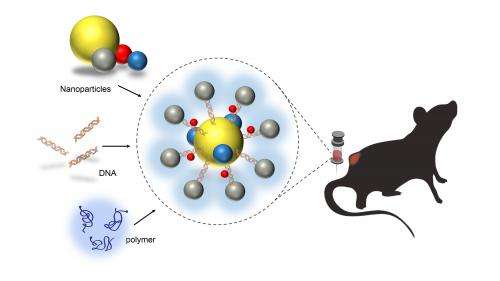January 27, 2014 report
Researchers use DNA strands to build decomposable nanostructures

(Phys.org) —A team of researchers in Canada has found a way around the problem of large nanostructures that are used to combat tumors, remaining in the body after they are no longer needed. In their paper published in the journal Nature Nanotechnology, the team describes a technique they developed where they used DNA strands to tie together small nanostructures creating larger nanostructures, that over time—after a tumor had been reduced—broke down and left the body.
Over the past several years, researchers have discovered that nanostructures, built from nanoparticles can be used to deliver drugs directly to a tumor, killing it. This is preferential to chemotherapy because it harms only tumor cells, rather than healthy cells throughout the body. The down side is that the nanostructures are made of materials that are considered toxic if they build up in the body and worse, are a little too big for the body to break down and get rid of. Thus, the nanostructures remain after they are no longer needed. To get around this problem, the researchers took a very unique approach, they used DNA strands to tie small nanostructures together, creating a large enough structure to transport tumor killing drugs. But because they are tied together with DNA, they become untied as the body breaks down the DNA strands. Once loosed, the nanostructures revert back to groups of smaller structures which the body can process and get rid of.
The concept was tested in mice, and results thus far indicate that the process worked as planned—the team was able to actually see the nanostructures as they appeared in the mouse urine, proving that the mice's systems were able to remove the smaller sized nanostructures from the tumor site and pass them through to the renal system.
The researchers report that their technique at this time shows promise, but of course, more work will have to be done to prove that the technique is safe, and that the nanostructures can hold together long enough to do their job. They believe their work will lead to new types of cancer killing agents, but they won't be ready for use in humans for at least five to ten years.
More information: DNA assembly of nanoparticle superstructures for controlled biological delivery and elimination, Nature Nanotechnology (2014) DOI: 10.1038/nnano.2013.309
Abstract
The assembly of nanomaterials using DNA can produce complex nanostructures, but the biological applications of these structures remain unexplored. Here, we describe the use of DNA to control the biological delivery and elimination of inorganic nanoparticles by organizing them into colloidal superstructures. The individual nanoparticles serve as building blocks, whose size, surface chemistry and assembly architecture dictate the overall superstructure design. These superstructures interact with cells and tissues as a function of their design, but subsequently degrade into building blocks that can escape biological sequestration. We demonstrate that this strategy reduces nanoparticle retention by macrophages and improves their in vivo tumour accumulation and whole-body elimination. Superstructures can be further functionalized to carry and protect imaging or therapeutic agents against enzymatic degradation. These results suggest a different strategy to engineer nanostructure interactions with biological systems and highlight new directions in the design of biodegradable and multifunctional nanomedicine.
Journal information: Nature Nanotechnology
© 2014 Phys.org


















